Results 1-11 of 11
<<< Previous 1 Next >>>
![[The Birmingham Hospitals Centre.]](img-thumbnail/jpegs/41344.jpg)
[The Birmingham Hospitals Centre.]
Stanley Anderson. [signature in pencil.]
[1938.]
Dry-point etching. Rare. Edition of 50. Framed. Plate: 345 x 230mm (13½ x 9"), Frame: 550 x 435mm (21¾ x 17"). Unexamined out of frame.
A view of the old Queen Elizabeth Hospital in Birmingham, designed by Thomas Arthur Lodge. The hospital was opened in 1939 by George VI and Queen Elizabeth after whom the hospital was named. The artist, Stanley Anderson (1884-1966) was famed for his detailed depictions of modern British life.
[Ref: 41344] £280.00
(£336.00 incl.VAT)
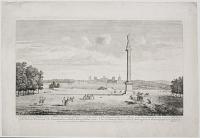
A North View of Blenheim House & Park, in the County of Oxford, one of the Seats of the Duke of Marlborough, w.th ye Monument which was erected in Memory of the late Duke. [parallel text in French]
Jno. Boydell delin & sculp
Publish'd according to Act of Parliament by J. Boydell Engraver; at the Unicorn, the corner of Queen Street, Cheapside, London, 1752.
Engraving, platemark 265 x 435mm (10½ x 17"), with very large margins.
View of Blenheim House in Woodstock, Oxfordshire. Following his victory at the Battle of Blenheim (known on the Continent as the Second Battle of Höchstädt) during the war of the Spanish Succession in 1704, the commander John Churchill, first duke of Marlborough was given land and £240,000 to build a palace as a gift from Queen Anne and the nation. Work on Blenheim Palace began the following year, to designs by Sir John Vanbrugh, although it was not completed until 1733, eleven years after Marlborough's death. He was commemorated by the 'Column of Victory' seen in the middle-ground of this print, which shows Marlborough dressed as a Roman general.
[Ref: 41188] £260.00
(£312.00 incl.VAT)
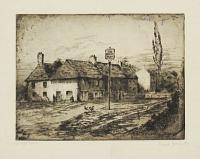
Herongate, Essex.
Frank Brangwyn [signed in pencil].
Etching, platemark 180 x 240mm (7 x 9½") very large margins.
The Boar's Head in Herongate, Essex, now a Grade II listed country pub. Etched by Frank William Brangwyn (Bruges, 1867 - London, 1956), one of the most influential etchers of the early twentieth century. Brangwyn had already established his reputation as a major painter and watercolourist at the time of his first etching in 1900. He was then quickly drawn more and more to the many possibilities of this artistic medium and by 1926 had completed 331 original etchings. Most of Brangwyn's art concentrated upon figure studies, architectural and marine subjects. He traveled extensively and many of his most famous etchings are of continental views, particularly scenes from Normandy, Belgium and Italy.
[Ref: 41222] £180.00
(£216.00 incl.VAT)
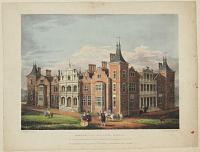
Houghton House, Beds. as originally erected 1616, by the Countess of Pembroke, 'Sidney's Sister' &c. From Elevations in the possession of Lord Holland, & from the Ruins by R.C. Stratfold.
J. Hewetson lithog. Printed by C. Hullmandel.
[n.d., c.1840.]
Fine original coloured lithograph. Sheet 240 x 320mm (9½ x 12½"). Mounted on album paper.
Houghton House, a Grade I listed ruin just north of Ampthill. Built by Mary Sidney Herbert, Dowager Countess of Pembroke, c.1615, and became the property of the Dukes of Bedford in 1738. In 1794 Francis Russell, 5th Duke of Bedford, stripped the house of its furnishings (the staircase is in The Swan Hotel in Bedford) and removed the roof, leaving it to decay, as it remains today.
[Ref: 41258] £140.00
(£168.00 incl.VAT)
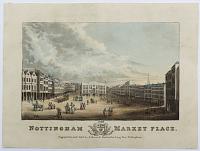
Nottingham Market Place. 1828
Engraved for and Sold by S. Bennett Bookseller, Long Row, Nottingham
Rare aquatint with hand-colouring, sheet 150 x 205mm (6 x 8").
The Exchange Building in the Market Square of Nottingham. The building was built to act as the meeting place of the Corporation of Nottingham, and it was demolished in 1926.
[Ref: 41419] £130.00
(£156.00 incl.VAT)
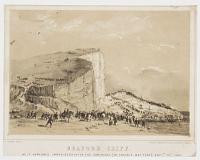
Seaford Cliff. As it appeared immediately after the explosion (by voltaic battery) Sept.ber 19th 1850
Miss Nanny del.t
Chapé & Lefevre lith 99 Guildford St. Russell Sq.e
Lithograph and tintstone, very scarce; sheet 150 x 190mm (6 x 7½").
The explosion at Seaford, Sussex in 1850, which was organised in order to blast away a huge mass of chalk cliff to create a large rock groyne and prevent pebbles from being transported from the Seaford Beach towards Beachy Head. As shown here, the event attracted vast crowds (including Charles Dickens, who wrote about it for 'Household Words'). The explosion took place successfully, but the chalk was blasted into very small fragments which, rather than retaining shingle at Seaford beach, merely accelerated the eastwards flow of sediment it was intended to prevent.
[Ref: 41284] £120.00
(£144.00 incl.VAT)
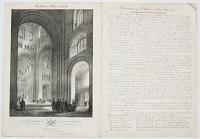
St Albans Abbey Church. To the Right Honourable the Earl of Verulam, Viscount Grimston, Baron Verulam of Gorhambury, Herts. A zealous Promoter of the Reparation of St Albans Abbery-Church, This Print is most respectfully inscribed by His Lordships very obedient, Humble Servant, Lewis Nockallls Cottingham. Architect.
Drawn on Stone by Mackenzie. Printed by C. Hullmandel.
[n.d., c.1832]
Pamphlet with lithograph on india and letterpress. Sheet: 555 x 380mm (21¾ x 15"). Centrefold as issued. Some creasing.
A view of the interior of the church of St Albans, now St Albans Cathedral. In 1832, part of the clerestory wall fell through the ceiling of the south aisle leaving a hole nearly 30ft long. Lewis Nockalls Cottingham was called in to survey the damage and to propose plans for repair. The acompanying letterpress presents the architects plans as well as stating the amount needed to be raised for the repair. Money was to be raised by public subscription and the letterpress lists the London banks, printsellers and Booksellers where subscriptions could be received. See Ref: 50099
[Ref: 41379] £120.00
(£144.00 incl.VAT)
![Windsor Bridge [in image]](img-thumbnail/jpegs/41386.jpg)
Windsor Bridge [in image]
W. Ingalton 1821 [in image]
Lithograph with hand-colouring, sheet 175 x 245mm (7 x 9½"). Trimmed and false margins added.
View of the Thames at Windsor, showing the second Datchet bridge which was built in 1812. Lithograph by William Ingalton (bap. 1794, d.1866), painter and builder. Ingalton lived most of his life at Eton and mostly painted scenes of the surrounding area. Ingalton gave up painting in around 1826 to become and architect and builder at Windsor.
[Ref: 41386] £130.00
(£156.00 incl.VAT)
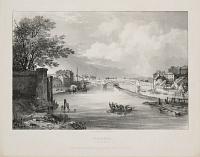
Windsor. New Bridge.
From Nature & on Stone by W. Gauci.
London Printed and Published by Engelmann, Graf, Coindet & Co, 92 Dean Street, Soho. March 1828.
Lithograph on india, india dimensions 220 x 275mm (8½ x 10¾").
The bridge at Windsor, opened in 1824, which is still in use after recent restoration and provides a connection between Windsor and Eton across the river Thames.
[Ref: 41413] £120.00
(£144.00 incl.VAT)
![Distant View of Windsor Castle from the Thames [ms].](img-thumbnail/jpegs/41387.jpg)
Distant View of Windsor Castle from the Thames [ms].
[probably William Ingalton c.1821]
Lithograph with hand-colouring, sheet 175 x 245mm (7 x 9½"). Trimmed and false margins added.
The royal residence of Windsor Castle. Lithograph probably by William Ingalton (bap. 1794, d.1866), painter and builder. Ingalton lived most of his life at Eton and mostly painted scenes of the surrounding area. Ingalton gave up painting in around 1826 to become and architect and builder at Windsor.
[Ref: 41387] £130.00
(£156.00 incl.VAT)
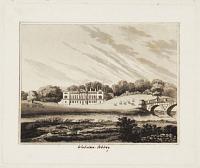
[Woburn House, Bedfordshire, The Residence of His Grace the Duke of Bedford.]
[Anon., c.1800.]
Aquatint, proof before letters. 245 x 300mm (9¾ x 12") very large margins. Stitch marks in top edge, old ink mss title in inscription area.
Woburn Abbey in Bedfordshire, family seat of the Duke of Bedford since 1547 when Henry VIII took it from its monastic residents. The architect Henry Flitcroft was employed from 1747 to rebuild the west wing of the house in the Palladian style as seen here.
[Ref: 41256] £140.00
(£168.00 incl.VAT)
<<< Previous 1 Next >>>
![[The Birmingham Hospitals Centre.]](img-thumbnail/jpegs/41344.jpg)






![Windsor Bridge [in image]](img-thumbnail/jpegs/41386.jpg)

![Distant View of Windsor Castle from the Thames [ms].](img-thumbnail/jpegs/41387.jpg)
